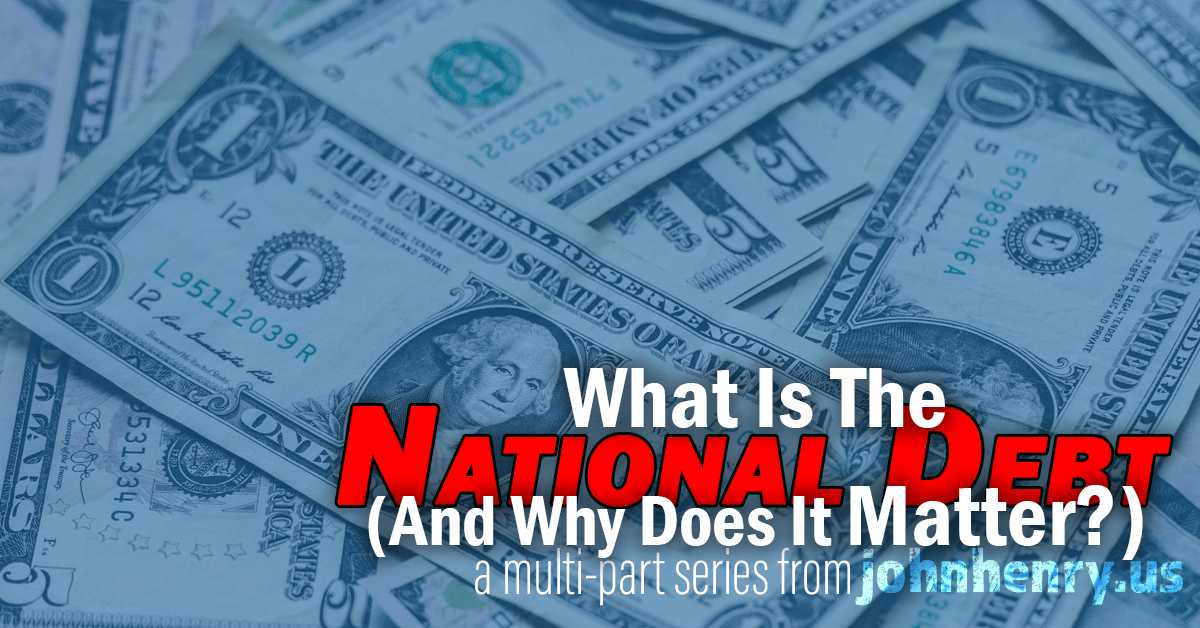A recent social media conversation brought forth the question, “what is the ‘national debt,’ really?”
This came by way of one person’s well-intended insistence that the national debt isn’t “debt” at all, really…which, is almost right, but also so hugely wrong that deconstructing it in a useful way that wasn’t dismissive or confrontational required a good deal more than a simple comment.
More to the point, when I realized the comment was approaching 700 words and not nearly done, I thought it would make a better blog post here…

So let’s talk about what’s wrong about our friend’s assessment, then why, then why it matters, and hopefully we’ll all walk away having learned something useful, and we’ll be better empowered to make well-reasoned decisions at the voting booth!
We began with a comment I saw in my feed that said “the only debt the US has is treasury bonds” or something to that effect, to which I replied “not quite true; 78% of the national debt is the money in circulation.”
This is a great place to note I was a bit wrong there. In a bit of synchronicity that number turns up in the current data, but the actual information I was communicating was something else and my communication was based on outdated data; the actual number is 76.6%. The information below is compiled from the most recent “Monthly Statement Of The Public Debt,” issued by the US Treasury Department.
- 22% of the “national debt” is debt held by various departments of the government against other departments of the government. This amounts to money deliveries and exchanges that haven’t yet been completed for one reason or another.
- Of the 78% (there’s that number) that remains – called “Debt Held By the Public” or “DHBP,” – 30% is held by foreign entities.
- 78 * .3 = 23.4. 100-23.4 = 76.6% of the national debt is, one way or the other, money we owe only to ourselves.
- That other 23.4% is the number on which our friend and I agree as being “debt.”
- In the sense that it is not the same as a e.g. a household, personal, or business debt, the original poster is right, however it is debt, and it’s important to understand how and why that is, in order to understand more completely “how money works.”
So with all of that said, it’s understandable that our correspondent insists that it’s “not debt.” That’s probably more correct than the general perception that this debt represents something that must be paid from some finite store of resources. Indeed, this debt will never be “paid off” or “balanced,” nor would you want it to be?
Why? Because even though there are a lot of misunderstandings about what it means, and those misunderstandings are very much leveraged maliciously against those who subscribe to them (and the vast majority of the rest of us), in the end from a standpoint of economics a dollar bill is a debt instrument, it’s a token representing a legally binding agreement that someone owes someone for something, and unraveling that is much more important than simply engaging in some grand “pulling back the curtain AHA YOU SEE? NOTHING!” gesture. Plus the gesture’s wrong. There’s definitely something there, and it matters. Just not how you probably think…and it all adds up to the simple reality that if the national debt were “paid off,” that would mean there are no more US dollars.
There are only two ways that’s going to happen: if the US unilaterally defines and adopts a successor currency (which it sort of already did, see notes further on in this series about the “gold standard”), or the US collapses entirely and ceases to exist as an operating entity.

A “debt” is something that is owed; a “fiat” or “token” is something that holds the place of the debt in a way that’s generally accepted as valid and enforceable by the general public. All paper currency (and most coinage now) is “fiat” currency. Currency’s not valuable in and of itself, it’s just paper (well, cloth) and ink, but it’s still valuable because we all agree to let it represent value under certain conditions and for certain purposes. (Coinage may have intrinsic value depending on the composition of the coin, but as far as I know there is currently no nation producing coins whose metal content is equal to the face value of the coin. US pennies, for instance, cost about $1.07 per dollar’s worth at current (2:18pm 15-May-23) commodity prices.)
In the case of your dollar bill (or its electronic representation in a bank computer somewhere), what it represents – what it is – is a token legally validating that “The United States” is owned, to the tune of 1/x where x= total $ in circulation, by the holder (or “owner”) of that dollar bill, whose ownership stake has not yet been converted to real property or services.
Ergo, “The United States” owes that person or entity one dollar’s worth of real property or services, which they have not yet claimed. (Note to self: stretch this into a separate short piece about the international bond market…) Unavoidably, by definition, every dollar “in circulation” is a dollar of debt.
NB: In this case ‘in circulation’ simply means it’s not in the government’s hands, nor is it in the hands of a governmental unit who is using it for trade, and includes ALL money, not just that which physically exists. About 95% of it doesn’t – around a trillion and a half of that debt is circulating currency and coinage, the rest is electronically recorded and doesn’t “really exist” at all. This is often used as a cheap-shot, elementary school rebuttal to the observation that the “national debt” is in point of fact the collected dollar savings of the United States, to the penny.
Savings accounts, the values of stocks, commercial lending, are all dollars “in circulation” in this sense, and they all represent a debt, usually on multiple levels. But getting back to dollars, the only exceptions are those which make their way into the hands of those who collect coins or currency as a hobby, or trades in those items as collectibles as a business. Then they become a “real resource” rather than a representation thereof. Even at that, the US government will happily cash in your silver and gold certificates and coinage at face value, just take it to any bank and they will replace your old worn-out five dollar bill or twenty dollar gold coin with a nice crisp new Federal Reserve Note in the amount of your bill or coin!
That is why a dollar bill is a debt, not because of some archaic and nefarious witch-doctoring by those mysterious bankers and businessmen. It’s literally a legally binding note saying the United States as a collective political entity owes you real property or services in the amount of that note, and there are very good reasons for that arrangement which are entirely without ideological or political cant; neither capitalism nor communism required.
In Part 2, we’ll take on the question of The Gold Standard, why we’re not on it, and why we definitely don’t want to be. Later we’ll talk about how you get “real value” out of your pile of notes and those ‘very good reasons’ I mentioned. See you soon!










